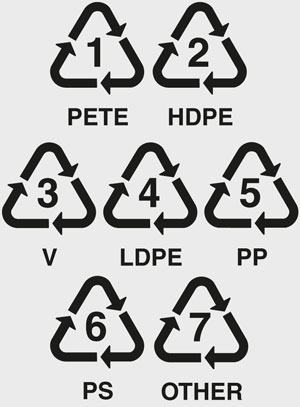Over the last few posts we have been talking about polymer sustainability, use of renewable sources for bio-polymers, Life Cycle Assessments, and Green Design. We highlighted that LCA ranking and Green Design rankings do not necessarily correlate exactly. For example, polyhydroxyalkanoate from corn grain (PHA-G) ranked very high in the Green Design ranking, but had a fairly low LCA ranking due to the need for fertilizers, pesticides, energy used to farm corn, grain processing etc.
So what does all this mean for most of us? Simply put – Recycle.
Recycling Numbers: what do they mean?
The recycling symbol we’re familiar with, a single digit number surrounded by a triangle of arrows was designed by The Society of the Plastics Industry (SPI) in 1988 to allow consumers and recyclers to differentiate types of plastics while providing a uniform coding system for manufacturers.
Here are the 7 designated polymer groups:
#1 PETE: Polyethylene Terephthalate.
#2 HDPE: High Density Polyethylene.
#3 V: Vinyl/Polyvinyl Chloride (PVC).
#4 LDPE: Low Density Polyethylene.
#5 PP: Polypropylene.
#6 PS: Polystyrene.
#7 OTHER: Other mixed resins.
Some plastics are easy to recycle and some are not.
The easiest and most common plastics to recycle are made of polyethylene terephthalate (PETE) and are assigned the number 1. Examples include soda and water bottles, medicine containers, and many other common consumer product containers. Once it has been processed by a recycling facility, PETE can become fiberfill for winter coats, sleeping bags and life jackets. It can also be used to make bean bags, rope, car bumpers, tennis ball felt, combs, cassette tapes, sails for boats, furniture and, of course, other plastic bottles.
Number 2 is high-density polyethylene plastics. These include heavier containers that hold laundry detergents and bleaches as well as milk, shampoo and motor oil. Plastic labeled with the number 2 is often recycled into toys, piping, plastic lumber and rope. Like plastic designated number 1, it is widely accepted at recycling centers.
Some Less Commonly Recycled Plastics
Polyvinyl chloride, commonly used in plastic pipes, shower curtains, medical tubing, vinyl dashboards, and even some baby bottle nipples, gets number 3. Like numbers 4 (wrapping films, grocery and sandwich bags, and other containers made of low-density polyethylene) and 5 (polypropylene containers used in Tupperware, among other products), few municipal recycling centers accept these polymers due to the low rate of recyclability.
What about all those packaging “peanuts” we seem to get in our packages?
Number 6 is used for polystyrene (Styrofoam) items such as coffee cups, disposable cutlery, meat trays, packing “peanuts” and insulation. It is widely accepted because it can be reprocessed into many items, including cassette tapes and rigid foam insulation.
Hardest Plastics to Recycle
Items made from combinations of the various plastics or from unique plastic formulations not commonly used are difficult to recycle. These types of products are typically layered (for example multilayer barrier films) or mixed plastic products (like the hard and soft polymers used in toothbrushes). These types of products are imprinted with a number 7 or nothing at all and are seldom recycled and are placed in the regular waste streams (landfilled or incinerated).
So when trash day comes at your home, do you recycle your plastics?
Do you keep recycling in mind when you are developing new products?
Click on the sign-up button to get our posts delivered by email so you can keep current on the latest tips and practices in polymers and innovation.


very nice post,Pipes industry is the biggest growing industry in the Africa and middle east. More than 92% construction companies importing pipes in the Nigeria and African countries i am impressed to read this information from the blog.
Great! How about cosmetics waste ? It also can be recycle? I am studying polymer chemistry and keep wondering if cosmetics waste can be recycled and produce new things
I’m confused. I had read that #3, 6 & 7 were non recyclable. Is this correct?